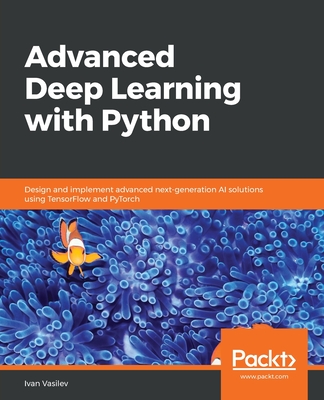Hands-On Deep Learning Algorithms with Python
暫譯: 使用 Python 實作深度學習演算法
Ravichandiran, Sudharsan
- 出版商: Packt Publishing
- 出版日期: 2019-07-29
- 定價: $1,500
- 售價: 9.0 折 $1,350
- 語言: 英文
- 頁數: 512
- 裝訂: Quality Paper - also called trade paper
- ISBN: 1789344158
- ISBN-13: 9781789344158
-
相關分類:
Python、程式語言、DeepLearning、Algorithms-data-structures
-
相關翻譯:
Python 深度學習算法實戰 (簡中版)
立即出貨 (庫存=1)
商品描述
| Learn |
|
|---|---|
| About |
Deep learning is one of the most popular domains in the AI space that allows you to develop multi-layered models of varying complexities.
This book introduces you to popular deep learning algorithms—from basic to advanced—and shows you how to implement them from scratch using TensorFlow. Throughout the book, you will gain insights into each algorithm, the mathematical principles involved, and how to implement it in the best possible manner. The book starts by explaining how you can build your own neural networks, followed by introducing you to TensorFlow, the powerful Python-based library for machine learning and deep learning. Moving on, you will get up to speed with gradient descent variants, such as NAG, AMSGrad, AdaDelta, Adam, and Nadam. The book will then provide you with insights into recurrent neural networks (RNNs) and LSTM and how to generate song lyrics with RNN. Next, you will master the math necessary to work with convolutional and capsule networks, widely used for image recognition tasks. You will also learn how machines understand the semantics of words and documents using CBOW, skip-gram, and PV-DM. Finally, you will explore GANs, including InfoGAN and LSGAN, and autoencoders, such as contractive autoencoders and VAE.
By the end of this book, you will be equipped with all the skills you need to implement deep learning in your own projects. |
| Features |
|
商品描述(中文翻譯)
更多資訊
學習內容
- 實作基本到進階的深度學習演算法
- 掌握深度學習演算法背後的數學原理
- 熟悉梯度下降法及其變體,如 AMSGrad、AdaDelta、Adam 和 Nadam
- 實作循環神經網路,如 RNN、LSTM、GRU 和 seq2seq 模型
- 理解機器如何使用 CNN 和膠囊網路解讀圖像
- 實作不同類型的生成對抗網路,如 CGAN、CycleGAN 和 StackGAN
- 探索各種自編碼器的類型,如稀疏自編碼器、DAE、CAE 和 VAE
關於本書
深度學習是人工智慧領域中最受歡迎的領域之一,允許您開發多層次、複雜度各異的模型。
本書將介紹流行的深度學習演算法——從基本到進階——並展示如何使用 TensorFlow 從零開始實作它們。在整本書中,您將深入了解每個演算法、所涉及的數學原理,以及如何以最佳方式實作它。書中首先解釋如何構建自己的神經網路,接著介紹 TensorFlow,這是一個強大的基於 Python 的機器學習和深度學習庫。接下來,您將熟悉梯度下降法的變體,如 NAG、AMSGrad、AdaDelta、Adam 和 Nadam。然後,本書將提供有關循環神經網路(RNN)和 LSTM 的見解,以及如何使用 RNN 生成歌曲歌詞。接下來,您將掌握處理卷積網路和膠囊網路所需的數學,這些網路廣泛用於圖像識別任務。您還將學習機器如何使用 CBOW、skip-gram 和 PV-DM 理解單詞和文檔的語義。最後,您將探索 GAN,包括 InfoGAN 和 LSGAN,以及自編碼器,如收縮自編碼器和 VAE。
在本書結束時,您將具備在自己的專案中實作深度學習所需的所有技能。
特色
- 快速掌握從零開始構建自己的神經網路
- 深入了解深度學習演算法背後的數學原理
- 使用 TensorFlow 實作流行的深度學習演算法,如 CNN、RNN 等






























